Experimental and Numerical Methods for the Evaluation of Sound Radiated by Vibrating Panels Excited by Electromagnetic Shakers in Automotive Applications
Abstract
:Featured Application
Abstract
1. Introduction
2. Materials and Methods
3. Results
3.1. Laboratory Measurements
3.2. Vehicle Panel Measurements
4. Conclusions
Author Contributions
Funding
Institutional Review Board Statement
Informed Consent Statement
Data Availability Statement
Conflicts of Interest
References
- Misdariis, N.; Pardo, L.-F. The Sound of Silence of Electric Vehicles—Issues and Answers. In Proceedings of the InterNoise, Hong-Kong, China, 27–30 August 2017. [Google Scholar]
- Du, X.; Liao, X.; Fu, Q.; Zong, C. Vibro-Acoustic Analysis of Rectangular Plate-Cavity Parallelepiped Coupling System Embedded with 2D Acoustic Black Holes. Appl. Sci. 2022, 12, 4097. [Google Scholar] [CrossRef]
- Guo, Z.; Pan, J.; Sheng, M. Vibro-Acoustic Performance of a Sandwich Plate with Periodically Inserted Resonators. Appl. Sci. 2019, 9, 3651. [Google Scholar] [CrossRef] [Green Version]
- Osterziel, J.; Zenger, F.J.; Becker, S. Sound Radiation of Aerodynamically Excited Flat Plates into Cavities. Appl. Sci. 2017, 7, 1062. [Google Scholar] [CrossRef] [Green Version]
- De Oliveira, L.P.R.; Varoto, P.S.; Sas, P.; Desmet, W. A State-Space Modeling Approach for Active Structural Acoustic Control. Shock Vib. 2009, 16, 797125. [Google Scholar] [CrossRef]
- Roberts, M.; Grieco, J.; Ellis, C. Diffuse-field Radiators in Automotive Sound System Design. In Proceedings of the 108th Audio Engineering Society Convention, Paris, France, 19–22 February 2000; p. 5163. [Google Scholar]
- Dhandole, S.; Modak, S.V. Review of vibro-acoustics analysis procedures for prediction of low frequency noise inside a cavity. In Proceedings of the 25th Conference & Exposition on Structural Dynamics, Orlando, FL, USA, 19–22 February 2007. [Google Scholar]
- Ma, X.; Wang, L.; Xu, J. Active Vibration Control of Rib Stiffened Plate by Using Decentralized Velocity Feedback Controllers with Inertial Actuators. Appl. Sci. 2019, 9, 3188. [Google Scholar] [CrossRef] [Green Version]
- Belicchi, C.; Opinto, A.; Martalo, M.; Tira, A.; Pinardi, D.; Farina, A.; Ferrari, G. ANC: A low-cost implementation perspective. In Proceedings of the 12th International Styrian Noise, Vibration & Harshness Congress: The European Automotive Noise Conference, Graz, Austria, 22–24 June 2022. [Google Scholar] [CrossRef]
- Tripodi, C.; Costalunga, A.; Ebri, L.; Vizzaccaro, M.; Cattani, L.; Ugolotti, E.; Nili, T. Experimental Results on Active Road Noise Cancellation in Car Interior. In Proceedings of the 144th Audio Engineering Society Convention, Milan, Italy, 23–26 May 2018; p. 9976. [Google Scholar]
- Tsuruta-Hamamura, M.; Kobayashi, T.; Kosuge, T.; Hasegawa, H. The Effect of a ‘Design-of-Awareness’ Process on Recognition of AVAS Sound of Quiet Vehicles. Appl. Sci. 2022, 12, 157. [Google Scholar] [CrossRef]
- Chatterjee, A.; Ranjan, V.; Azam, M.S.; Rao, M. Comparison for the Effect of Different Attachment of Point Masses on Vibroacoustic Behavior of Parabolic Tapered Annular Circular Plate. Appl. Sci. 2019, 9, 745. [Google Scholar] [CrossRef] [Green Version]
- Anerao, N.; Kumar, T. Vibro-Acoustic Reciprocity Analysis Using Dodecahedral Sound Source and Its Application for Material Assessment. 2020. Available online: https://www.researchgate.net/profile/Nitesh-Anerao/publication/349830062_Vibro-Acoustic_reciprocity_analysis_using_dodecahedral_sound_source_and_it’s_application_for_material_assessment/links/60427d114585154e8c78a0fa/Vibro-Acoustic-reciprocity-analysis-using-dodecahedral-sound-source-and-its-application-for-material-assessment.pdf (accessed on 5 March 2021).
- Dowsett, A.; O’Boy, D.; Walsh, S.; Abolfathi, A.; Fisher, S. The prediction of measurement variability in an automotive application by the use of a coherence formulation. Proc. Inst. Mech. Eng. Pt. D J. Automob. Eng. 2018, 232, 1694–1700. [Google Scholar] [CrossRef]
- Scislo, L. Quality Assurance and Control of Steel Blade Production Using Full Non-Contact Frequency Response Analysis and 3D Laser Doppler Scanning Vibrometry System. In Proceedings of the 2021 11th IEEE International Conference on Intelligent Data Acquisition and Advanced Computing Systems: Technology and Applications (IDAACS), Cracow, Poland, 22–25 September 2021; Volume 1, pp. 419–423. [Google Scholar] [CrossRef]
- Scislo, L.; Guinchard, M. Non-invasive Measurements of Ultra-Lightweight Composite Materials using Laser Doppler Vibrometry System. In Proceedings of the 26th International Congress on Sound and Vibration, Montreal bridges, QC, Canada, 7–11 July 2019; Available online: https://www.researchgate.net/publication/358090716_Non-invasive_measurements_of_ultra-lightweight_composite_materials_using_Laser_Doppler_Vibrometry_system (accessed on 25 January 2022).
- Collini, L.; Farina, A.; Garziera, R.; Pinardi, D.; Riabova, K. Application of laser vibrometer for the study of loudspeaker dynamics. Mater. Today Proc. 2017, 4, 5773–5778. [Google Scholar] [CrossRef]
- Molina-Viedma, Á.; López-Alba, E.; Felipe-Sesé, L.; Díaz, F.; Rodríguez-Ahlquist, J.; Iglesias-Vallejo, M. Modal Parameters Evaluation in a Full-Scale Aircraft Demonstrator under Different Environmental Conditions Using HS 3D-DIC. Materials 2018, 11, 230. [Google Scholar] [CrossRef] [PubMed] [Green Version]
- Seguel, F.; Meruane, V. Damage assessment in a sandwich panel based on full-field vibration measurements. J. Sound Vib. 2018, 417, 1–18. [Google Scholar] [CrossRef]
- Di Lorenzo, E.; Mastrodicasa, D.; Wittevrongel, L.; Lava, P.; Peeters, B. Full-Field Modal Analysis by Using Digital Image Correlation Technique. In Rotating Machinery, Optical Methods & Scanning LDV Methods; Springer: Cham, Switzerland, 2020; Volume 6, pp. 119–130. [Google Scholar]
- Pinardi, D.; Farina, A.; Park, J.-S. Low Frequency Simulations for Ambisonics Auralization of a Car Sound System. In Proceedings of the 2021 Immersive and 3D Audio: From Architecture to Automotive (I3DA), Bologna, Italy, 8–10 September 2021; pp. 1–10. [Google Scholar] [CrossRef]
- Pinardi, D.; Riabova, K.; Binelli, M.; Farina, A.; Park, J.-S. Geometrical Acoustics Simulations for Ambisonics Auralization of a Car Sound System at High Frequency. In Proceedings of the 2021 Immersive and 3D Audio: From Architecture to Automotive (I3DA), Bologna, Italy, 8–10 September 2021; pp. 1–10. [Google Scholar] [CrossRef]
- Misak, S.; Pokorny, V.; Kacor, P. Modeling of Acoustic Short Circuits. In Intelligent Data Analysis and Applications; Springer: Cham, Switzerland, 2015; pp. 121–131. [Google Scholar]
- Tira, A.; Pinardi, D.; Belicchi, C.; Farina, A.; Figuretti, A.; Izzo, S. ANC: A Low-Cost Implementation Perspective. In Proceedings of the 12th International Styrian Noise, Vibration and Harshness Congress: The European Automotive Noise Conference, Graz, Austria, 22–24 June 2022. [Google Scholar] [CrossRef]
- COMSOL. Acoustics Module User’s Guide. Available online: https://doc.comsol.com/5.4/doc/com.comsol.help.aco/AcousticsModuleUsersGuide.pdf (accessed on 26 October 2022).
- Leissa, A.W. The historical bases of the Rayleigh and Ritz methods. J. Sound Vib. 2005, 287, 961–978. [Google Scholar] [CrossRef]
- Kuznetsov, S. SH-waves in laminated plates. Q. Appl. Math. 2006, 64, 153–165. [Google Scholar] [CrossRef]
- Goldstein, R.V.; Kuznetsov, S.V. Long-Wave Asymptotics of Lamb Waves. Mech. Solids 2017, 52, 700–707. [Google Scholar] [CrossRef]
- Bellini, M.C.; Collini, L.; Farina, A.; Pinardi, D.; Riabova, K. Measurements of loudspeakers with a laser doppler vibrometer and the exponential sine sweep excitation technique. J. Audio Eng. Soc. 2017, 65, 600–612. [Google Scholar] [CrossRef]
- Sung, C.-C.; Jan, C.T. Active control of structurally radiated sound from plates. J. Acoust. Soc. Am. 1997, 102, 370–381. [Google Scholar] [CrossRef]
- Klippel, W.; Schlechter, J. Distributed Mechanical Parameters Describing Vibration and Sound Radiation of Loudspeaker Drive Units. In Proceedings of the 125th Audio Engineering Society Convention, San Francisco, CA, USA, 2–5 October 2008; p. 7531. [Google Scholar]
- Farina, A. Simultaneous Measurement of Impulse Response and Distortion with a Swept-Sine Technique. In Proceedings of the 108th Audio Engineering Society Convention, Paris, France, 19–22 February 2000; p. 5093. [Google Scholar]

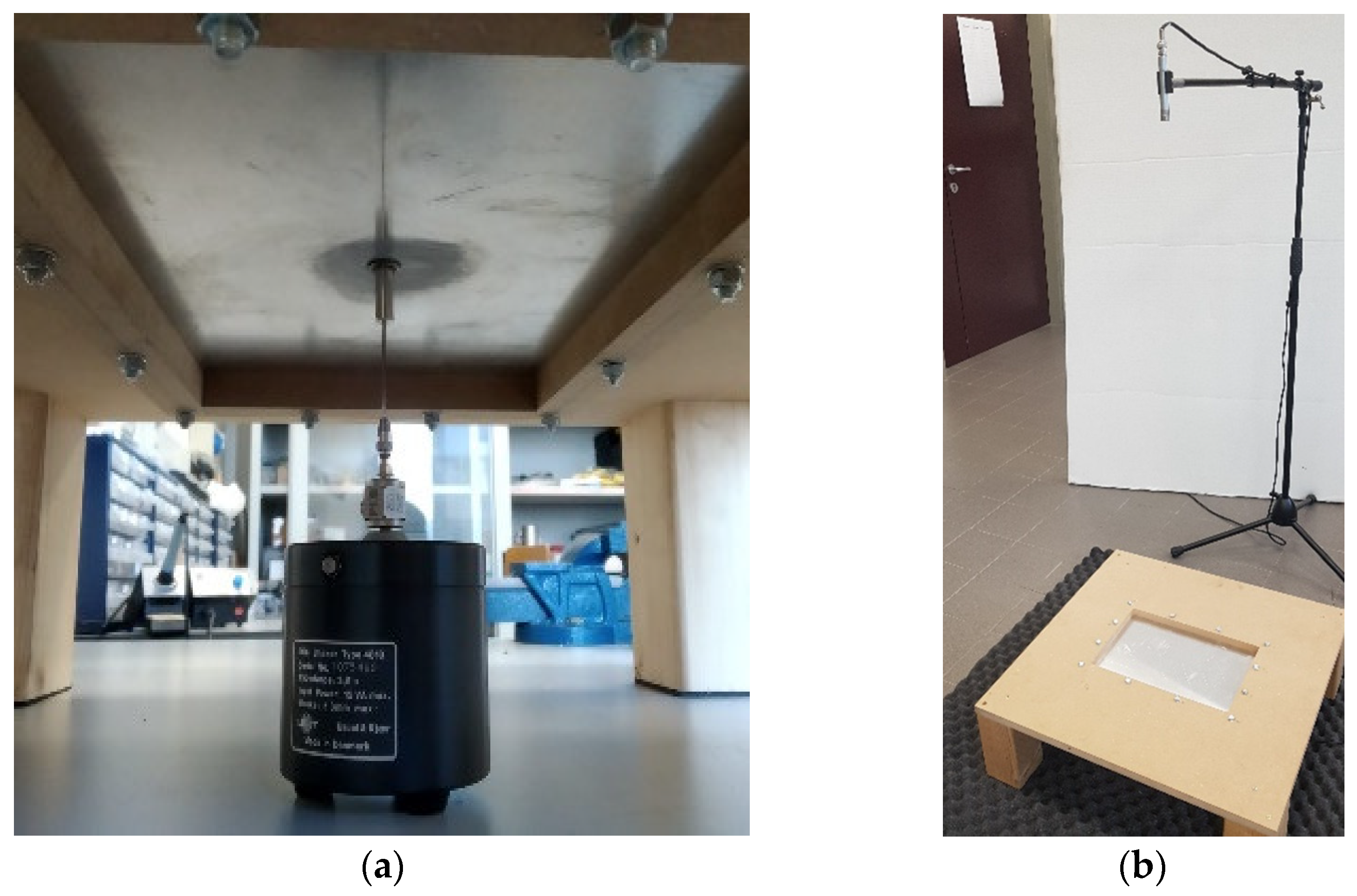

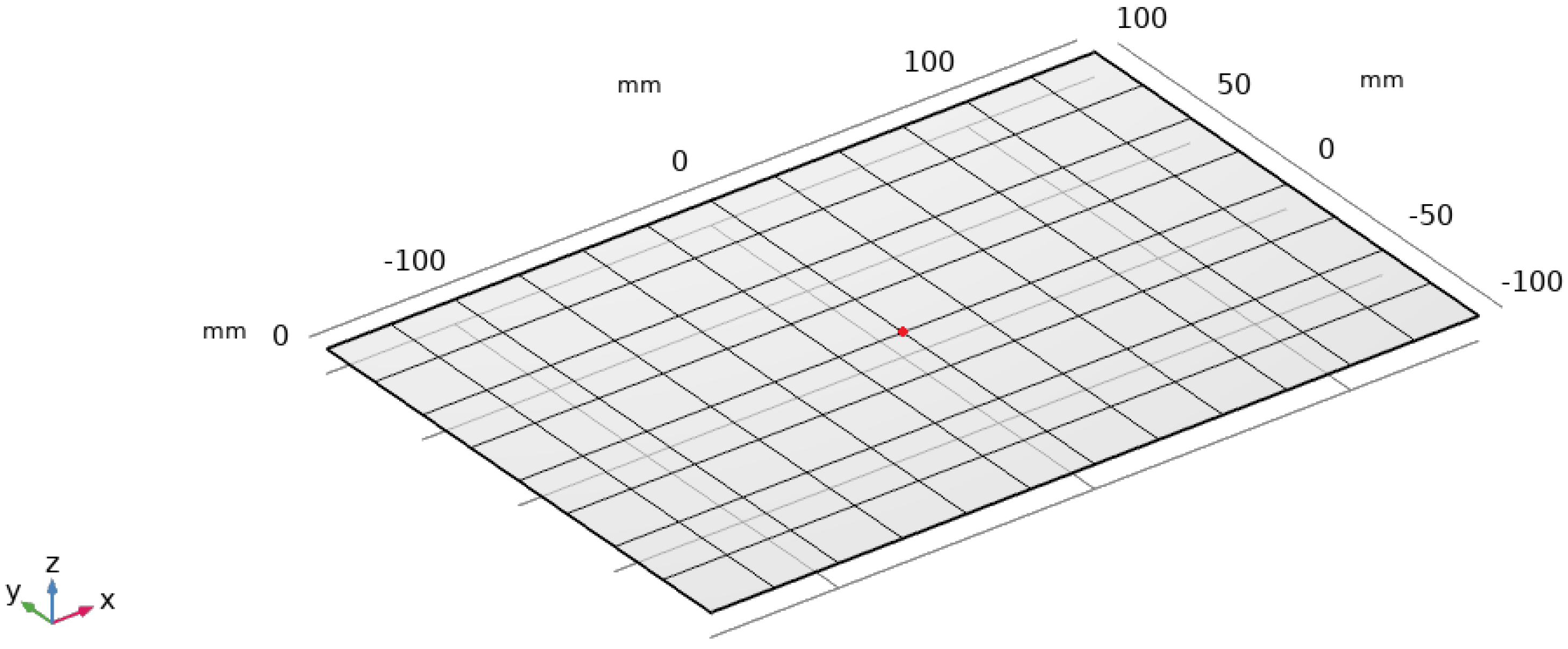
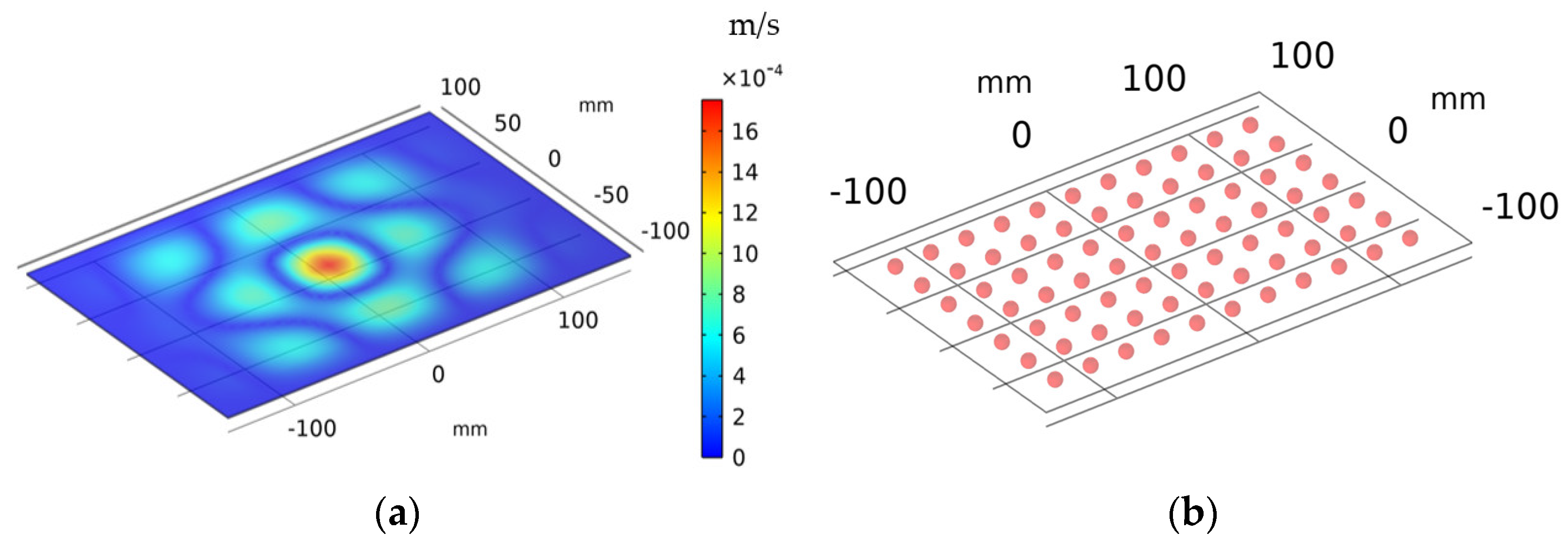
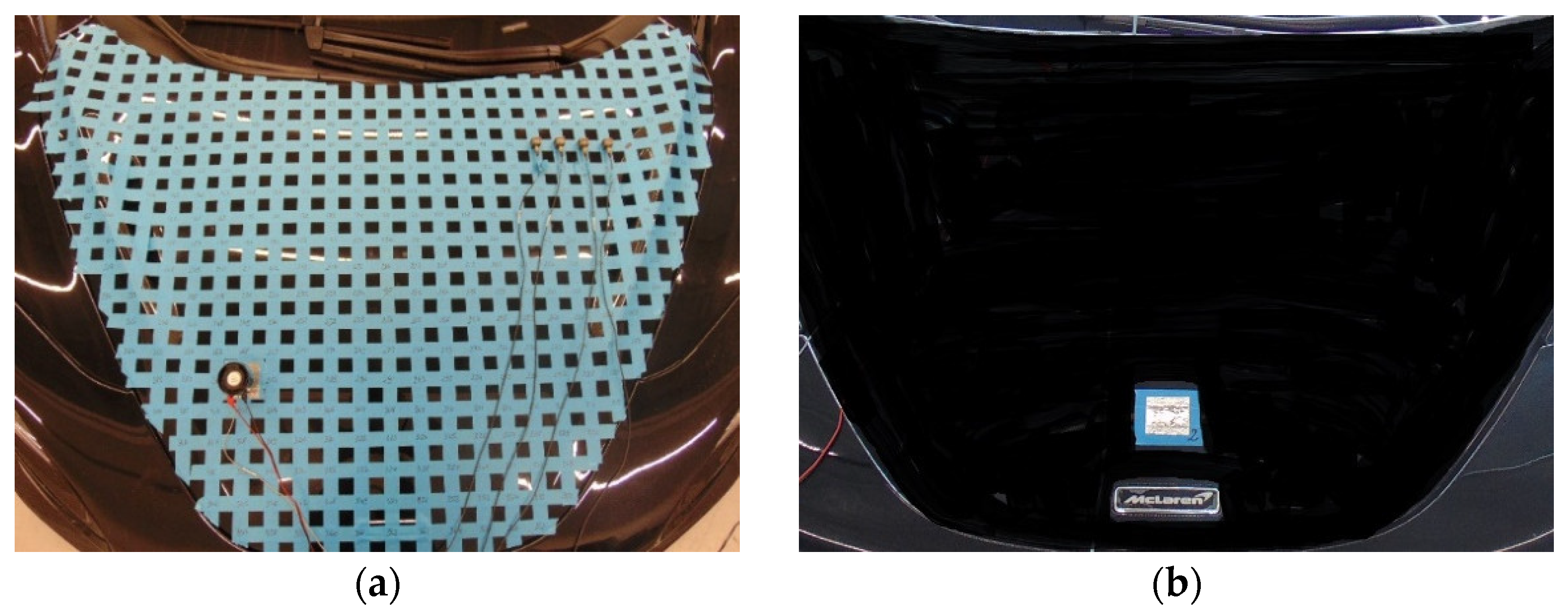
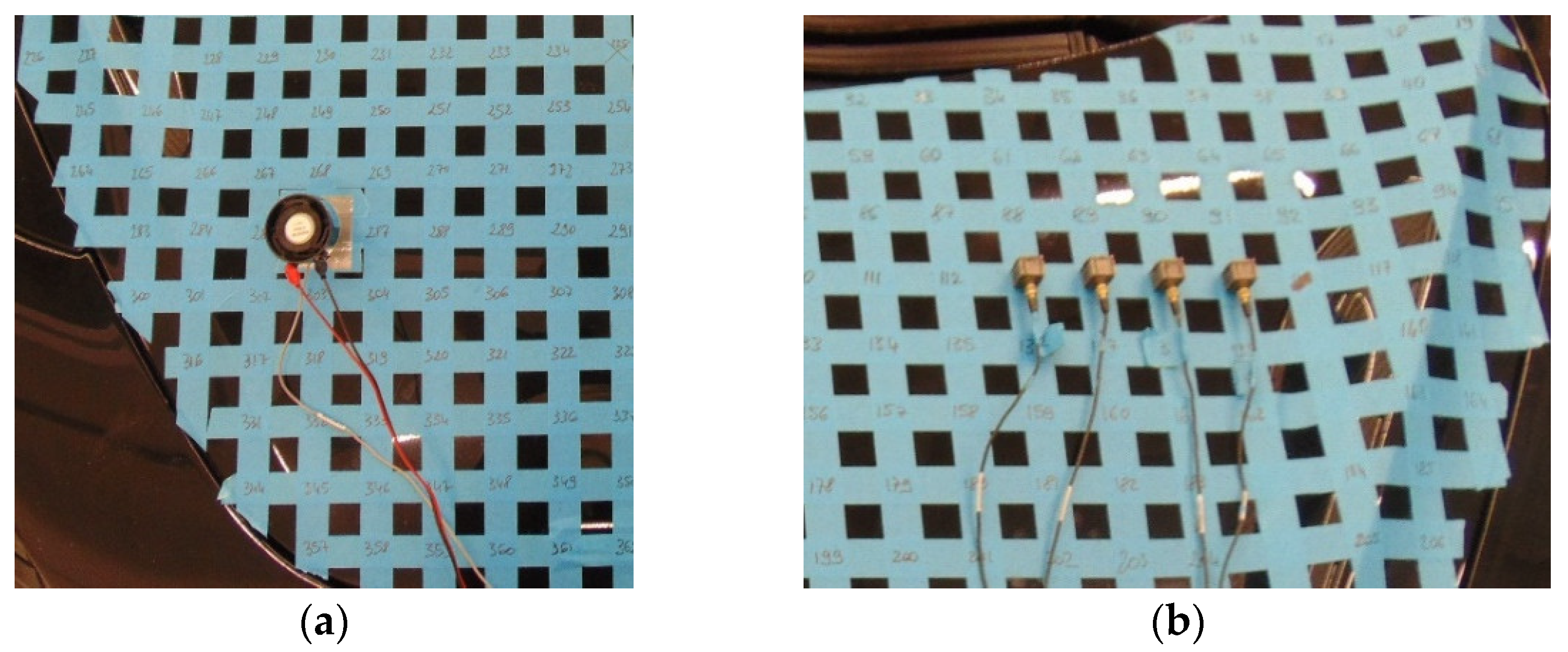
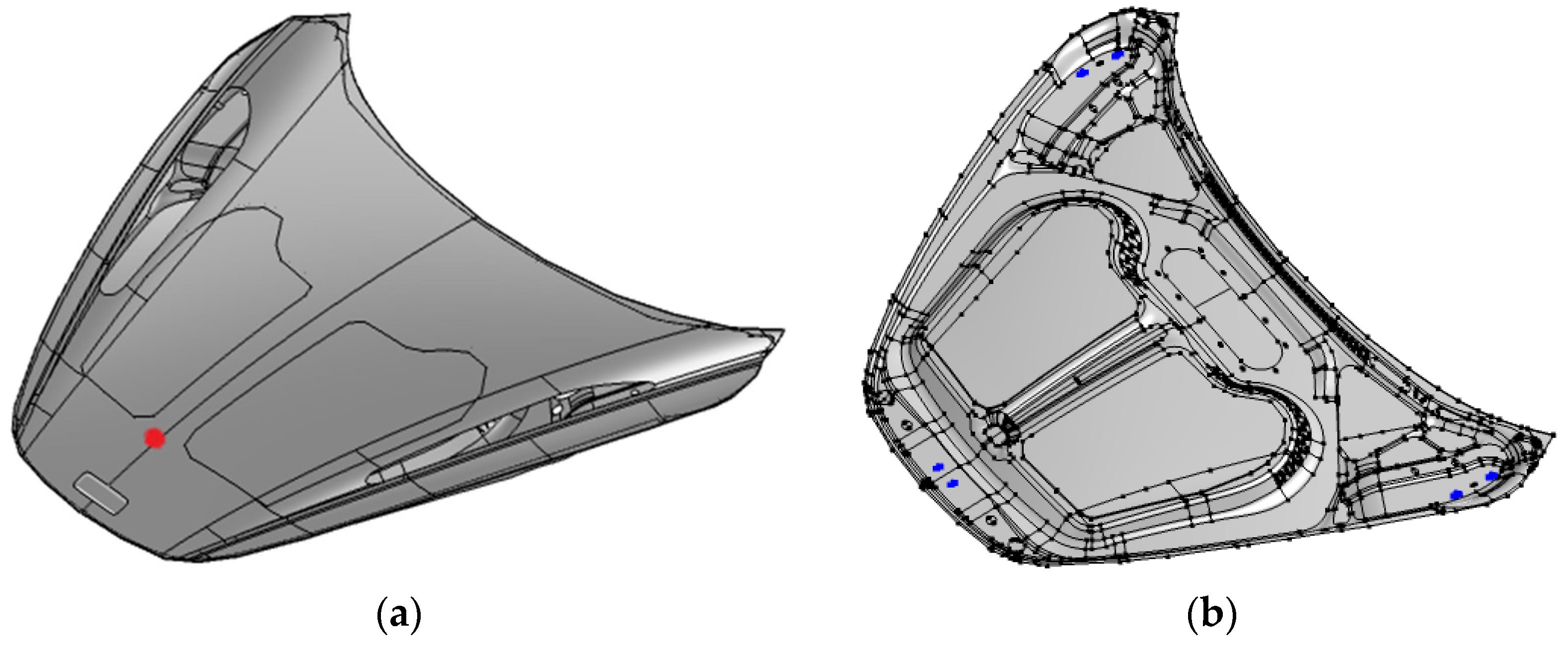
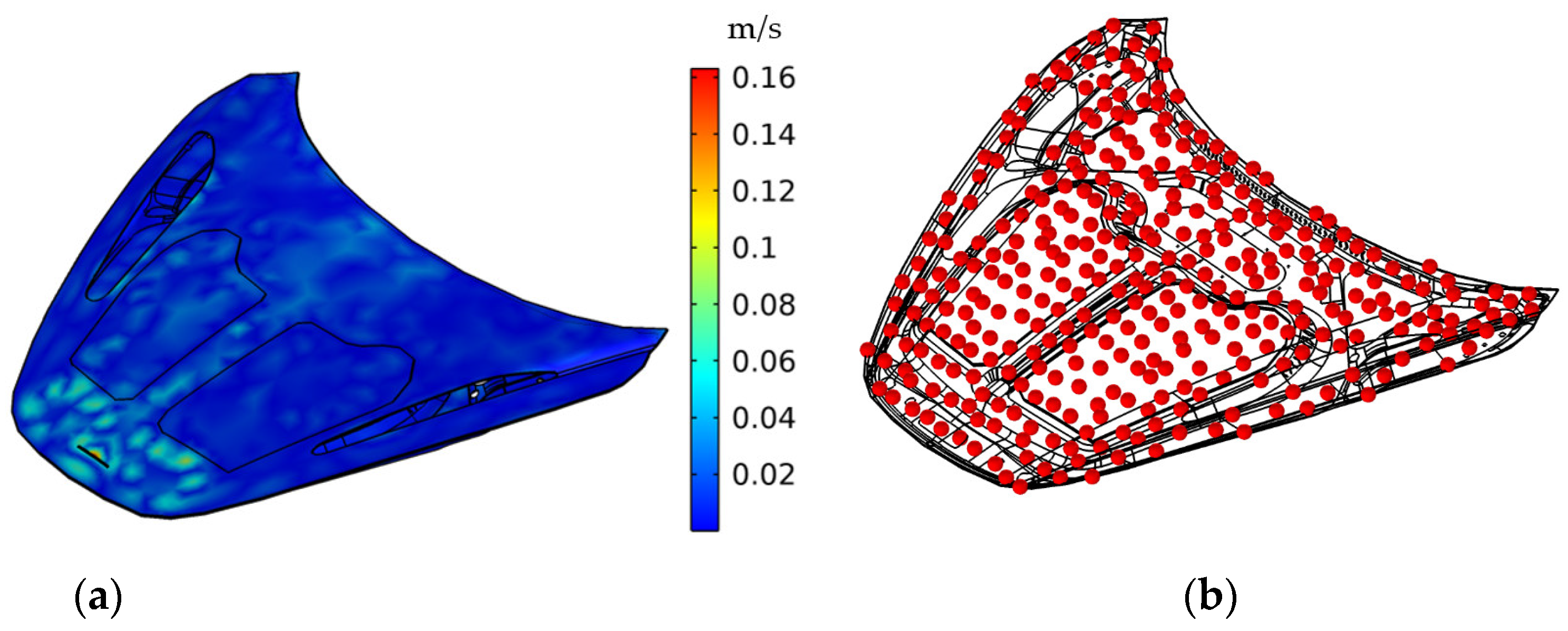


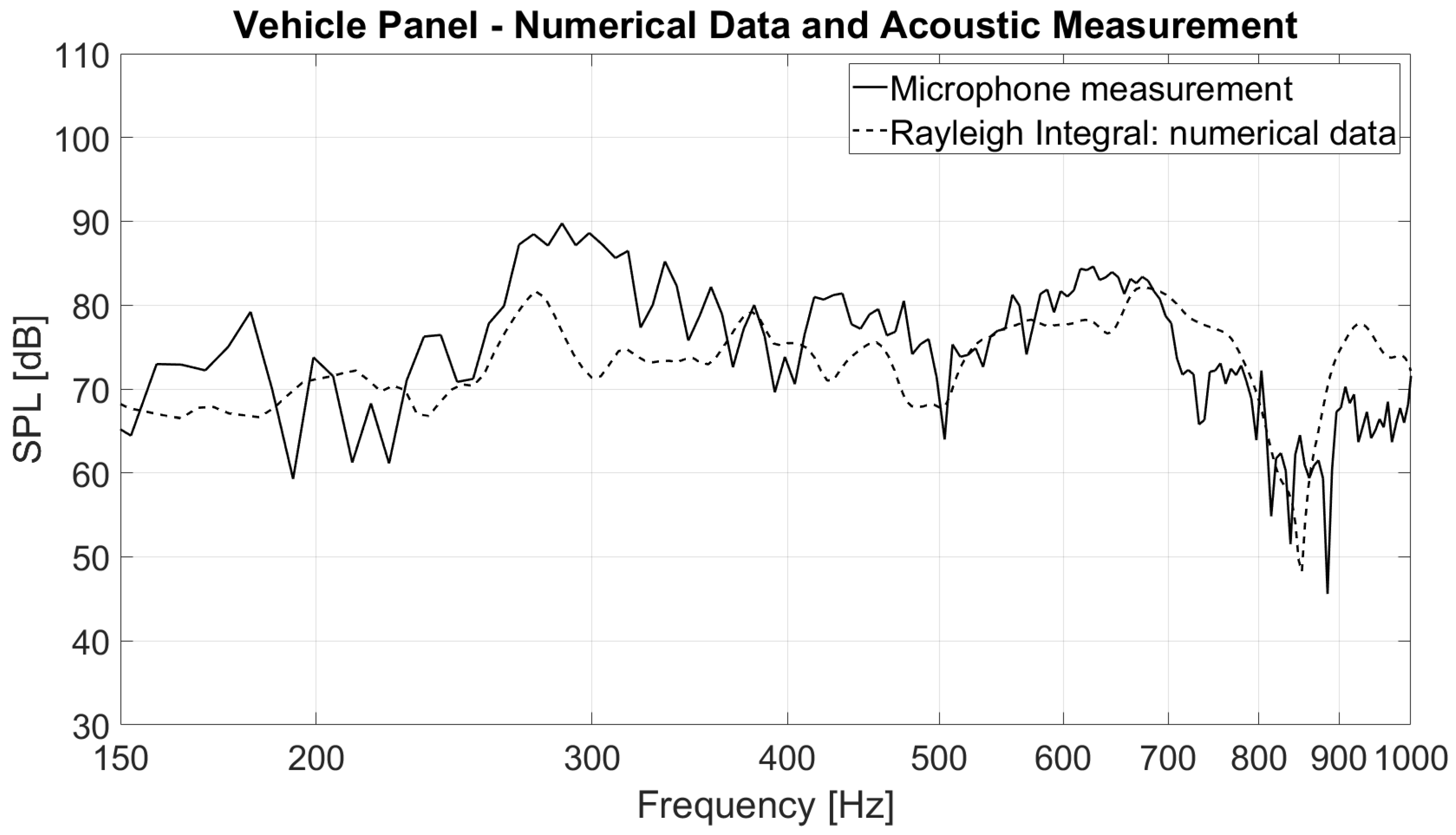
Publisher’s Note: MDPI stays neutral with regard to jurisdictional claims in published maps and institutional affiliations. |
© 2022 by the authors. Licensee MDPI, Basel, Switzerland. This article is an open access article distributed under the terms and conditions of the Creative Commons Attribution (CC BY) license (https://creativecommons.org/licenses/by/4.0/).
Share and Cite
Tira, A.; Pinardi, D.; Farina, A.; Figuretti, A.; Palmieri, D. Experimental and Numerical Methods for the Evaluation of Sound Radiated by Vibrating Panels Excited by Electromagnetic Shakers in Automotive Applications. Appl. Sci. 2022, 12, 11210. https://doi.org/10.3390/app122111210
Tira A, Pinardi D, Farina A, Figuretti A, Palmieri D. Experimental and Numerical Methods for the Evaluation of Sound Radiated by Vibrating Panels Excited by Electromagnetic Shakers in Automotive Applications. Applied Sciences. 2022; 12(21):11210. https://doi.org/10.3390/app122111210
Chicago/Turabian StyleTira, Anna, Daniel Pinardi, Angelo Farina, Alessio Figuretti, and Davide Palmieri. 2022. "Experimental and Numerical Methods for the Evaluation of Sound Radiated by Vibrating Panels Excited by Electromagnetic Shakers in Automotive Applications" Applied Sciences 12, no. 21: 11210. https://doi.org/10.3390/app122111210




